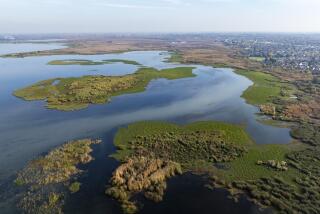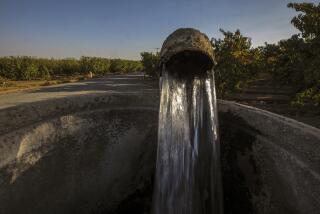Newton: Water ethics and a peripheral canal
Jeff Hart is a scientist who knows the history of the San Joaquin-Sacramento River Delta better than most. He explains its emergence from the Ice Age, traces it through the arrival of the Spanish, recalls the figures of the California Gold Rush and points out the reeds that give shelter today to its wild fowl and fish. Last week, as we skimmed across the breezy waters of Steamboat Slough, a rivulet of the delta just south of Sacramento, he reflected on all that and argued for a “water ethic” that would re-envision humanity’s relationship to its most basic substance.
Hart, a cheerful man with a scraggly beard, suggests that such an ethic would represent an extension of conservationist Aldo Leopold’s famous “land ethic.” Leopold’s vision of human respect for the Earth was once a revolutionary notion, yet it has now become an accepted theme of modern politics. But what would a water ethic look like, especially in California, which has never hesitated to claim distant waters to serve human needs?
That may sound like an abstract question, given that water is there for any Californian at the turn of a tap. It irrigates farms in the Imperial Valley, where rain rarely falls. It waters lush lawns in Los Angeles and San Diego. But for residents of the delta, the relationship between water and humans is far from abstract. It is immediate and threatening.
Gov. Jerry Brown has made it undeniably clear that he intends to complete an unfinished bit of business from his first stint as governor by securing Southern California’s water supply from the delta.
The last time Brown was in office, in the early 1980s, he supported a ballot initiative to authorize the building of a so-called peripheral canal, a pipe or aqueduct that would draw water from the Sacramento River and funnel it south. The measure went down to defeat, with Northern California voters overwhelmingly opposed.
Now, in his second incarnation as governor, Brown is determined to complete this work. Advocates of the canal have some strong arguments. Drawing water from the delta’s southern intakes, as happens now, alters the natural flows of the region and creates problems for fish; pulling water from farther north would alleviate the problem. Also, the levees that allow the area to exist are susceptible to earthquakes and could collapse in the Big One; taking water out before it gets to them would protect the water supply. And finally, the water needs of Southern California are real and compelling.
But Doug Hemly has every right to be skeptical. His family arrived in the delta in 1850, when two brothers made their way up the Sacramento River. One headed for the gold fields; the other established a farm. The miner went bust while the farmer, despite a fire that destroyed his first hay crop, prospered. Seven generations later, the Hemly family farms pears, along with some cherries and blueberries, on the banks of the Sacramento. A peripheral canal would suck up water they rely on and sell it to someone else.
We all know the story of the Owens Valley, which was sacrificed to Los Angeles when William Mulholland and the ruling class of this city — including the onetime owners of this newspaper — swindled farmers out of their water rights. But those farmers sold an uncertain future for cash on the nail. The Hemlys and other delta farmers have an established business and heritage, and they aren’t interested in cashing out.
What’s especially galling to them is where the water would go. The modern peripheral canal would send more than 1 million acre-feet of water annually to urban customers in the Silicon Valley and Southern California. But the lion’s share, more than two-thirds, would go to farms in the Central Valley, where farmers with outsized political influence have a big interest in the outcome.
Jeff Kightlinger, who runs the Metropolitan Water District, argues that it’s not one or the other, that water can be drawn from the delta without destroying its farms. He’s an honest broker and a smart one, and I hope he’s right, but you can understand why delta residents are unconvinced. They see Southern California coming after their water and endangering their livelihoods for the benefit of other farmers with greater clout.
With this project, Brown has the opportunity to adjust California’s historic relationship to water. As he does so, he should keep these principles in mind: Moving water is not a sin, but using it to favor big farms over family farms is unacceptable. And protecting Southern California’s water future is commendable, but it shouldn’t come at the expense of the delta’s.
That’s a sustainable water ethic.
Jim Newton’s column appears Mondays. His latest book is “Eisenhower: The White House Years.” Reach him at jim.newton@latimes.com or follow him on Twitter: @newton_jim.
More to Read
A cure for the common opinion
Get thought-provoking perspectives with our weekly newsletter.
You may occasionally receive promotional content from the Los Angeles Times.







